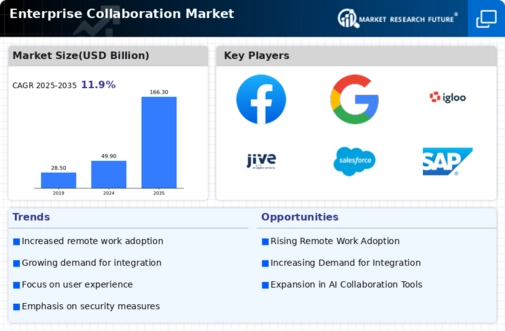Globalization of Business Operations
The globalization of business operations is a key driver in the Global Enterprise Collaboration Market Industry. As companies expand their reach across borders, the need for effective collaboration tools becomes paramount. Organizations require platforms that can support diverse teams working in different time zones and cultures. This demand is reflected in the market's projected growth, reaching 166.3 USD Billion by 2035. The ability to collaborate seamlessly across geographical boundaries not only enhances productivity but also fosters innovation, as diverse perspectives contribute to problem-solving and creativity in the workplace.
Integration of Advanced Technologies
The integration of advanced technologies such as artificial intelligence and machine learning is transforming the Global Enterprise Collaboration Market Industry. These technologies enhance collaboration tools by providing features like automated scheduling, intelligent document management, and real-time analytics. As organizations strive for efficiency, the adoption of these innovations is likely to increase. The market is expected to grow significantly, with a projected CAGR of 11.56% from 2025 to 2035. This growth reflects the potential of technology to streamline workflows and improve decision-making processes, ultimately leading to enhanced collaboration among teams.
Rising Demand for Remote Work Solutions
The Global Enterprise Collaboration Market Industry experiences a notable surge in demand for remote work solutions. As organizations increasingly adopt flexible work arrangements, tools that facilitate seamless communication and collaboration become essential. In 2024, the market is projected to reach 49.9 USD Billion, driven by the need for platforms that support virtual meetings, file sharing, and project management. Companies are investing in technologies that enhance productivity and foster teamwork, indicating a shift towards a more interconnected workforce. This trend suggests that the market will continue to expand as businesses recognize the value of effective collaboration tools.
Need for Enhanced Security and Compliance
The increasing need for enhanced security and compliance measures is shaping the Global Enterprise Collaboration Market Industry. As organizations handle sensitive data, the demand for secure collaboration tools rises. Companies are seeking solutions that not only facilitate communication but also ensure data protection and regulatory compliance. This trend is likely to drive market growth, as businesses prioritize security in their collaboration strategies. The emphasis on safeguarding information while maintaining efficient workflows indicates a critical intersection of security and collaboration in the evolving business environment.
Focus on Employee Engagement and Productivity
A growing emphasis on employee engagement and productivity is influencing the Global Enterprise Collaboration Market Industry. Organizations recognize that effective collaboration tools can enhance employee satisfaction and drive performance. By providing platforms that facilitate communication and teamwork, companies can create a more engaged workforce. This focus is likely to contribute to the market's expansion, as businesses invest in solutions that promote collaboration and streamline processes. The potential for improved employee morale and productivity underscores the importance of these tools in today's competitive landscape.



















Leave a Comment